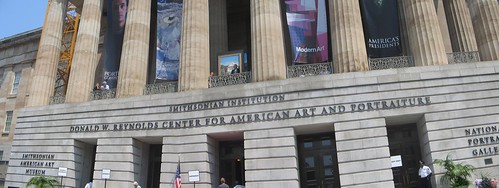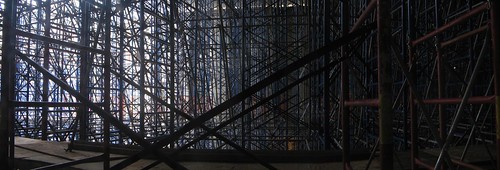It was definitely a Smithsonian weekend, spent almost exclusively at the newly reopened Reynolds Center (or Old Patent Office Building, as Washingtonians still prefer to call it). The museums are pure high-density art, three floors crammed with collections of all sorts, portraits and landscapes and genre paintings and sculptures and furniture and other works spanning all eras of American history. It took us a full museum day just to cover the better part of the “American Origins” collection and the Outwin Boochever Portrait Competition (with a lunch break at La Tasca for paella and embutido), then another day to cover the second floor American Art galleries and Presidential portraits. We’re still recovering from museum fatigue right now.
Opening Day had some fun stuff going on: newsboys in early 20th Century style garb around the block, yelling “EXTRA, ETXTRA!” while giving out museum opening pamphlets, a live American Gothic tableau overlooking the F Street entrance, free ice cream and popsicles at the G Street entrance, barbershop quartets, George and Martha Washington, and Charlie Chaplin. Amy and I even ran into Marilyn Monroe in the Great Hall, asking us if we had seen her Warhol portrait yet. I told her I had, and I had also enjoyed her 1953 calendar pinups. (The look I got in response didn’t exactly say “seven year itch.”)
Not all of the building is open yet; the central courtyard is still in progress, filled with a thick, intricate scaffolding which could itself be considered a veritable work of industrial art:
This is a museum worth coming back to again and again; there’s tons to see and learn, and each collection is worth hours of poring over. The Old Patent Office Building is right by Gallery Place/Chinatown on the Red Line. Within the building, the lines between National Portrait Gallery and Museum of American Art can be kind of blurred, especially on the second floor, so be ready to wander.
More photos from opening weekend here. Also see Eye Level (the Smithsonian’s official American Art Museum weblog), DCist, ReadExpress, and the WaPo museum page.











